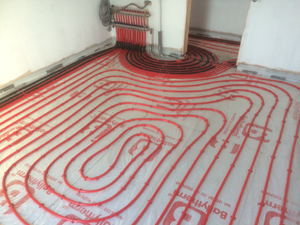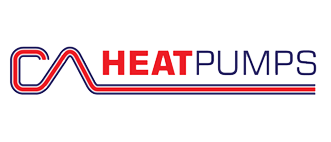UNDERFLOOR HEATING
Underfloor heating is a far from new concept and has been in existence since the days of the Romans. Voids were constructed under buildings where fires were lit creating warm air which would pass through the voids and heat the structure of the building. Since Roman times underfloor heating has, as one would expect, advanced dramatically. Electric underfloor heating has been around for many years when cheap night time electricity tariffs were used to heat up the thermal mass of a building. This however proved expensive and heating up periods targeted the day time use of the building; come evening time the building was cooling off.

Wet based underfloor heating is now commonplace throughout the construction industry with increasing installations. Heat pumps are most ideally suited to producing low temperatures which complement a well designed wet based underfloor heating system. Whenever efficiency of heat pumps is described, it is usually expressed in terms of COP (Coefficient of Performance) – the ratio of electrical input to thermal output.
Underfloor Heating
COP’s are measured under standard conditions and will more often be measured assuming the heat pump is connected to an underfloor heating system when the heat pump is at its most efficient – typically around a COP of 4 or 400% efficient. Therefore, when thinking about installing a heat pump a major consideration is the heat distribution system. A heat pump should be matched with the most effective method of heat distribution – underfloor heating.
If the underfloor heating system is designed and applied correctly, a heat pump should run to its optimum efficiency creating very low running costs and therefore a faster payback period on the initial investment.
Benefits of Underfloor Heating
- Underfloor heating creates an ideal warmth throughout a property. Heat is more evenly distributed throughout rooms with no ‘pockets of heat’ which often occurs when using conventional radiators.
- The temperature rise from the floor creates a more comfortable level of heat. The floor is warmer compared to that of the ceiling which is more pleasant for the way the human body reacts (we like our feet warm but not too hot around our heads). This is the opposite to how conventional radiators work where the majority of heat rises towards the ceiling and as it cools, it falls, creating a convection cycle.
- Underfloor heating is a space saver releasing valuable space which might otherwise be taken up by radiators. The initial installation costs are more expensive than a radiator system but more use is gained from individual rooms because there is the freedom for interior design
- It reduces energy consumption by using low water temperatures which is again why it is so compatible with heat pumps.
- Vandal proof – for properties being let, there is added peace of mind.
- It creates a cleaner environment in which to live. With no radiators to clean, dust circulating around the room is reduced benefiting sufferers of asthma or allergies.
- Little or no maintenance.
Floor Finishing
Many people do not appreciate the impact a floor covering can have on underfloor heating. Heat will go down as well as rise, necessitating the floor to be well insulated. Any covering on a screed/underfloor can act as a buffer and in theory insulate the surface preventing heat from rising. All new houses or conversions will have moisture and it is recommended to dry out floors before covering. With this in mind, however, heat pumps should not be used to ‘dry out’ a building. The screed should be allowed time to cure/dry out and heat pumps should only be used to gradually raise the temperature. Some heat pumps have a built-in facility for ‘screed drying’. Screed should dry out at a rate of 1mm per day for the first 50mm – longer if thicker.
- All stone, ceramic or slate floors are recommended as they allow excellent heat transfer when laid on concrete and screed.
- Carpet is suitable – however the underlay and carpet should not exceed 12mm. The combined TOG rating of the carpet and underlay should not exceed 1.5 TOG.
- Vinyl should not be too thick (i.e. max 5mm). It is important when using Vinyl to ensure that all moisture in the floor is eliminated and that a suitable glue is used when fixing.
- Wooden floors can act as an insulator. Engineered wood is recommended over solid wood because the moisture content is sealed within the boards but the thickness of the boards should not exceed 22mm.
- Solid wood floors should be dried and seasoned to reduce the moisture content. Ensure also that the screed has been fully dried and all the moisture eliminated before laying any wooden finish.
If considering putting down a wooden floor it is recommended to seek the advice of the manufacturer/supplier to ensure that it is compatible with underfloor heating. As with all underfloor installations and to achieve maximum heat output, good contact between the floor structure and floor covering is essential.
